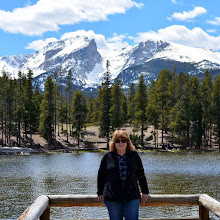On my last blog post, I showed the excursion my husband and I took to see the amazing Hubbard Glacier in Yakutat Bay, Alaska, up close, including a video of it caving. The next day of our cruise we were headed on an inner passage into Glacier Bay National Park and Preserve. The morning began with incredible scenery outside our stateroom balcony and viewing Glacier Bay including seeing Park Rangers coming aboard our Princess Cruise ship. Most visitors to Glacier Bay National Park and Preserve spend a day in Glacier Bay on large cruise ships as part of a longer cruise originating at a major west coast city. It is an amazing day cruising through the best of Alaska. The spectacular scenery and wildlife of Glacier Bay make it a highlight of any Alaska cruise. The ship travels into the heart of the Fairweather Mountains for a trip into the ice ages. (All photos will enlarge if clicked on)
In the ship's theater, a ranger gave us a preview talk about what we were going to view that day, as our cruise ship sailed to the terminus of the national park's inlet where the Grand Pacific and Margerie Glaciers are located, and then turn and sail back out.
I can not describe it better than what is said on the US National Park's service web page for Glacier Bay National Park:
"From the bottom of the deepest glacial fjord to the summit of its highest peak, Glacier Bay encompasses some of our continent's most amazing scenery and wildness. It is a land reborn, a world returning to life, a living lesson in resilience. If ever we needed a place to intrigue and inspire us, this is it. Glacier Bay is a homeland, a living laboratory, a national park, a designated wilderness, a biosphere reserve, and a world heritage site. It's a marine park, where great adventure awaits by boating into inlets, coves and hideaway harbors. It's also a land park, with its snow-capped mountains, spectacular glaciers, and emerald–green forests. From the summit to sea, Glacier Bay's wildness is remote, dynamic and intact."
As you can see from the photo above our cruise ship sailed serenely into the bay, close to the shoreline for excellent views of wildlife and whales
Glacier Bay has been home to the Huna Tlingit people for countless generations. 250 years ago a single large tidewater glacier covered all of Glacier Bay. By 1750 the glacier began to retreat and has now retreated 60 miles to the head of the bay. Currently, glaciers cover 27 % of the park, in 2,055 square miles. There are 50 named glaciers, 7 of which are active tidewater glaciers that calve icebergs into the sea, Most of the glaciers originate in the mountains at 8,000 to 15,000 feet elevation. The Grand Pacific, Brady, and Carroll Glaciers all exceed 200 square miles. In general, Tidewater and terrestrial glaciers have been receding over the years, with the exception of the Johns Hopkins and Margerie Glaciers. More history about the glaciers can be read on this link.
One after another we sailed passed glaciers...
...and majestic snowcapped mountains.
My husband viewed the Johns Hopkins Glacier from our balcony.
The scenery was incredible. The ship's lunch buffet was a fabulous array of fresh Alaskan seafood of all kinds--what a treat!
Such beauty!
The mountains, shorelines, and waterways of Glacier Bay are massive, dwarfing even the largest cruise ship. Wildlife is abundant, yet often appears small. The National Park Service Rangers were on the public decks to help in searching for wildlife such as grizzly bears, bald eagles, harbor seals, humpback whales, mountain goats, and even puffins! We searched through our binoculars and saw seals and whale fins and many birds.
Looking back at the shoreline where we had just sailed past.
A glacier calving
This glacier appeared to have a cross shape in the ice.
The beautiful blue ice of the Margerie Glacier...
..and the dark black ice of the Grand Pacific Glacier.
Jagged mountain peaks!
Lush green shoreline in some areas.
Massive mountains...
...and some melting glaciers.
Reflections...
...and islands.
The sail back out of the inner passage of Glacier Bay National Park had equally beautiful views.
As the sun sets, we enjoyed listening to a soprano singing opera arias in the ship's main floor atrium. We took this cruise in June, and my husband and I both had birthdays that month, so that evening we there were balloons and "Happy Birthday" greetings outside our stateroom, and we were treated to special birthday cake desserts at dinner. It was the end of a most wonderful day!
Our next few cruise stops would be the Alaskan cites of Skagway, Juneau, and Ketchikan, and more onshore excursions...please come back to my blog soon, to see more!
You can also find me on
I'm linking this post to the following blog events:
Mosaic Monday, All Seasons, Blue Monday, Through My Lens Monday, Little Cottage Link Party, Blogging Grandmothers, Hearth, and Soul Link Party, You Are the Star Blog Hop, Good Random Fun, Nature Notes, Grand Social, Travel Photos, Photo Tunes, Happiness Is Homemade, Something Old Is New, Our World Tuesday, Ruby Tuesday, Tuesdays With A Twist, Wordless Wednesday on a Tuesday, Say Cheese!, Party in Your PJ's, Wordless Wednesday, Nanahood WW, Oh My Heartsie Girl's Wonderful Wednesday, Your Whims Wednesday, Worldless Wednesday at Sky Girl, Wednesday My Corner of the World, Wonderful Wednesday, Little Things Thursday,Thankful Thursday, Thursday Encouraging Hearts and Home, Thursday Favorite Things, Friendship Fridays, Friday Features Linky Party, Friday Photo Journal, Skywatch Friday,Funtastic Friday, Pink Saturday, Saturday Critters,
Over the Moon Grammys Grid-Month Long Linky Party

































































